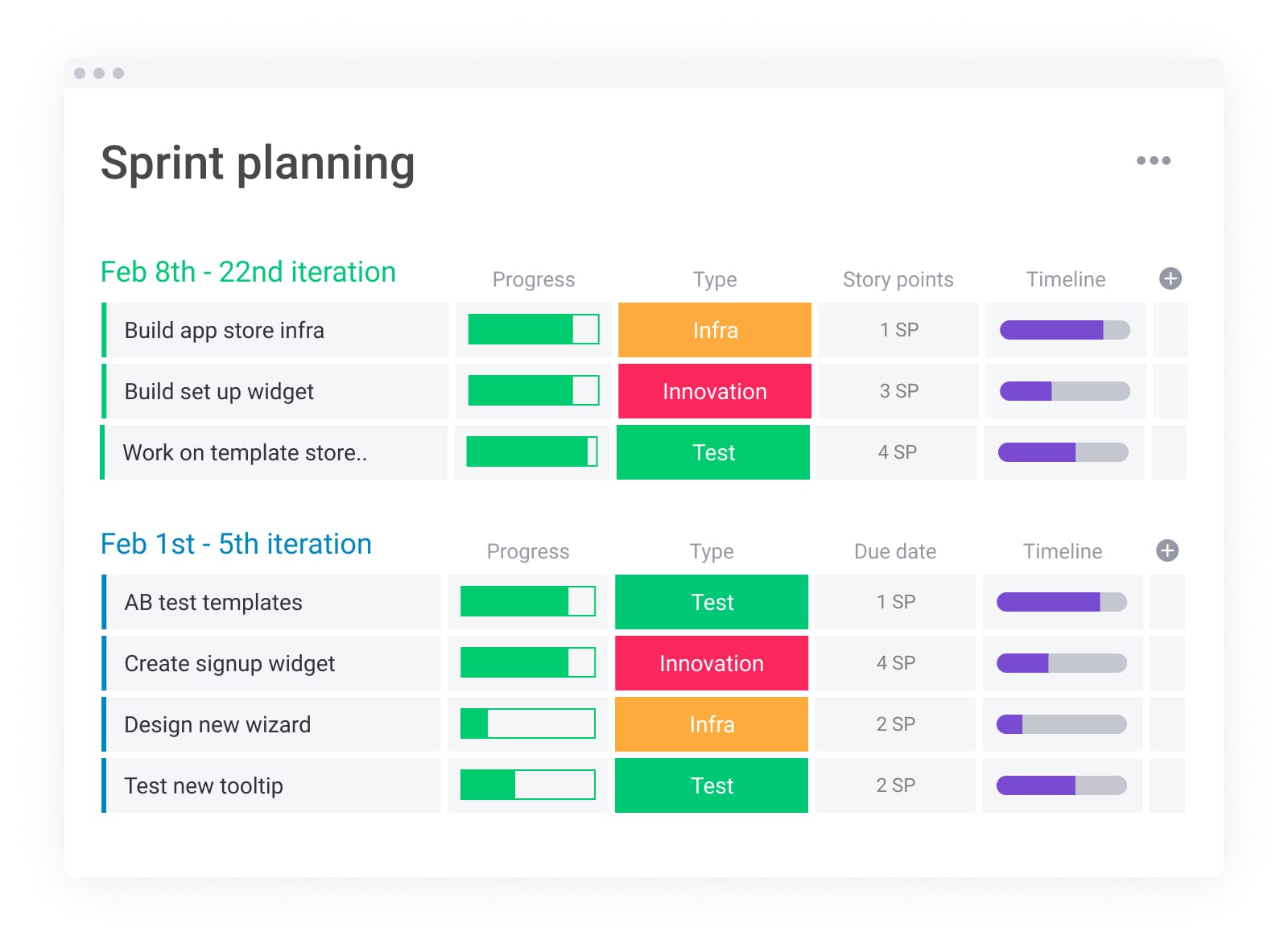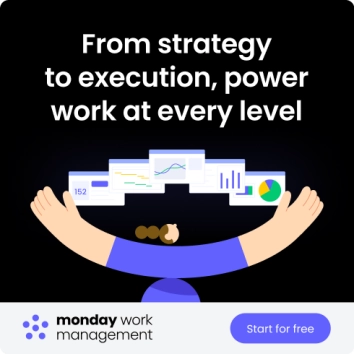Budgets can make or break any project. To succeed, you need to keep a close watch on your cash, time, and resources at all times, and be ready to make adjustments instantly. It sounds tough, but that’s where effective cost management comes in. It’s the process of budgeting, allocating, and controlling costs to ensure your team has what they need, when they need it.
Effective cost management isn’t just a separate task; it’s the natural result of a well-managed workflow. When your processes are clear and your data is visible, cost control becomes second nature. This guide will walk you through the key steps of the cost management process and show you how monday.com can help you master your expenses.
TL;DR
Cost management involves four key steps: resource planning, cost estimation and budgeting, cost control, and cost analysis. Using a Work OS like monday.com simplifies this process by providing tools for real-time tracking, automation, and data-driven reporting, turning financial oversight into a seamless part of your workflow.
What is cost management?
What is cost management?
Cost management is the process teams use to estimate, allocate, and control project costs. In simple terms, it helps organizations predict their financial needs to avoid going over budget. This is critical for any business. Without a clear forecast of project expenses, you risk running out of funds midway, which can lead to project—and even business—failure.
To prevent this, project managers monitor both direct and indirect costs throughout the project lifecycle. This process ensures that resources are used wisely and that the project stays on a path to profitability. While it might sound complex, it’s a straightforward practice that provides a financial baseline for every decision.

Why is cost management crucial for business success?
Why is cost management crucial for business success?
Effective cost management is more than just saving money; it’s a strategic practice that strengthens your entire project planning process. Here are three major benefits:
- It helps you avoid overruns. By carefully planning and allocating funds during the initial stages of a project, you make it significantly easier to prevent overspending and keep your finances on track.
- It helps you lower risk levels. Projects rarely go exactly as planned. A solid cost management process includes a budget for risk, so when unforeseen costs arise, they don’t derail your entire project.
- It helps you future-proof your processes. After a project is complete, you can compare your projected costs against actual spending. This analysis provides valuable data and reports, helping you refine your forecasting for future projects and use resources more efficiently.
The 4 key steps of the cost management process
The 4 key steps of the cost management process
While every business has its own unique style, a successful cost management process can always be broken down into four distinct phases: planning, estimation, control, and analysis.
Step 1: Resource planning
Before any work begins, you need a clear understanding of the resources required. This initial step involves identifying everything you’ll need to complete the project, including labor, materials, and equipment. A comprehensive resource planning stage ensures that every potential cost is considered from the outset, forming the foundation of your entire budget.
Step 2: Cost estimation and budgeting
Once you know what resources you need, the next step is to estimate their cost. This involves calculating the expected expense for each project component and compiling it into a detailed project budget. This budget serves as your financial roadmap. For example, a restaurant would calculate the cost of every ingredient for each dish to set its menu prices accurately. This detailed breakdown is then presented to stakeholders for approval, ensuring everyone is aligned on the expected spending.

Step 3: Cost control and monitoring
With an approved budget, you can start spending. However, cost control is an ongoing process of monitoring and recording all expenses as they occur. You must constantly compare your actual spending against your budget and project schedule to ensure you’re staying on track. If you notice variances, you may need to implement cost-cutting measures or reallocate funds from an area that is under budget to keep the project balanced.
Step 4: Cost analysis and reporting
After the project is completed, it’s time for the post-game analysis. This final phase involves a thorough review of your budgeted costs versus your actual spending. By examining any variances, you can identify patterns, pinpoint areas where you struggled to stay within budget, and discover where you may have over-budgeted. These insights are invaluable, as they can be applied to your next project to create more accurate forecasts and drive greater efficiency.
Common cost management challenges (and how to solve them)
Common cost management challenges (and how to solve them)
Even with a solid plan, teams often face challenges that can derail their budgets. Here are a few common hurdles and how a Work OS can help you overcome them.
- Inaccurate forecasting: If a project’s scope isn’t fully understood from the start, initial estimates can be far off, leading to overruns. Solution: Use customizable templates and historical data on monday.com to create more accurate forecasts based on past project performance.
- Scope creep: Unplanned changes or additions to a project can quickly inflate costs. Solution: Manage all project requests through monday.com forms to maintain a clear record of all changes and their impact on the budget and timeline.
- Lack of real-time visibility: Using outdated tools like spreadsheets makes it difficult to track spending in real-time, so you don’t know you’re over budget until it’s too late. Solution: Build live dashboards on monday.com to get an at-a-glance view of your budget, expenses, and remaining funds at any moment.

How a Work OS simplifies cost management
How a Work OS simplifies cost management
A Work OS (Work Operating System) like monday.com is a cloud-based platform where teams can build custom workflows to plan, run, and track all their work—including costs. It centralizes everything, making it easier to manage your finances alongside your project tasks.
Here’s how monday.com helps with cost management:
- Centralized tracking: Set up your project board with columns for budgeted amounts and actual expenses. The platform automatically calculates totals, so you always know where you stand.
- Powerful visualizations: Use real-time dashboards to see your financial data at a glance. Customizable widgets turn complex numbers into easy-to-understand charts and graphs, helping you demonstrate budget performance to stakeholders.
- Seamless integrations: Connect monday.com with your favorite financial tools through seamless integrations to keep all your data in one place.
- Time-saving automations: Reduce manual work with powerful automations. For example, set up a rule to automatically notify the finance team whenever an expense over a certain amount is logged.
- AI-powered insights: Leverage AI to automatically summarize weekly budget reports or generate task lists for cost-saving initiatives. This frees up your team for more strategic work.
With a dedicated Budget Tracking template and customizable features, monday.com is designed to make cost management simple and intuitive. To learn more about how a Work OS can transform your processes, we’ll break it down for you.

Cost management best practices for 2025
Cost management best practices for 2025
To take your cost management to the next level, consider adopting these best practices:
- Standardize your processes: Use templates to create a consistent approach to budgeting and expense tracking across all projects. This makes it easier to compare data and identify trends.
- Leverage automation: Automate recurring tasks like sending budget reminders or generating weekly reports. This saves time and reduces the risk of human error.
- Foster a cost-conscious culture: When everyone on the team understands the budget and their role in maintaining it, they are more likely to make financially responsible decisions. Use shared dashboards to promote transparency.
- Conduct regular reviews: Don’t wait until a project is over to analyze your spending. Schedule regular budget reviews to catch potential issues early and make adjustments as needed.
FAQs
Frequently asked questions about cost management
Gain control of your costs with monday.com
Gain control of your costs with monday.com
At the end of the day, cost management is essential. The process is designed to make sure you’re properly estimating, allocating, and controlling every cost involved in your team’s projects. Without a dynamic and detailed budget, it’s nearly impossible to ensure you have enough cash and resources to see your project through to completion.
With monday.com, it’s simple. We provide all the budgeting tools, reporting features, and templates you need to stay within your budget and deliver successful projects every time. Ready to see how monday.com can supercharge your cost management?
- Tags:
- Project cost management
 Get started
Get started 


